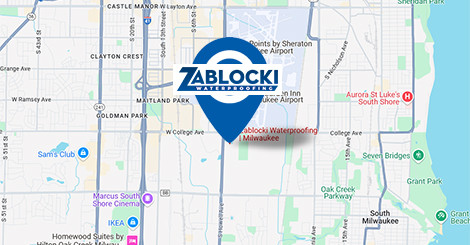Backfill: refers to the process of, or material used in, refilling a hole or trench dug around a foundation, basement, or crawlspace.
Basement: the floor or section of a home that is built either partially or completely below ground level.
Basement floor slab: the concrete floor of a basement.
Basement waterproofing: describes a number of strategies used to prevent water accumulation and damage in the lowest level of a home.
Below-grade: the part of a home or building that is below ground.
Bleeder: a useful tool for keeping your basement dry. Usually constructed from PVC pipe or concrete, this pipe acts as a drain, releasing water from outside the foundation into basement drain tiles, which prevents the water from entering and settling in the basement itself.
Bowing walls: below-grade walls that curve inwards or otherwise shift due to pressure from soil and other materials on the outside. Bowed walls can lead to cracks and leave a basement vulnerable to water leakage and damage.
Check valve: commonly used in sump pumps, this small device allows water to flow in only one direction; a useful tool in basement waterproofing.
Cinder block: commonly used to build basement foundations and walls, cinder blocks are a strong building material made from a mixture of cinders and concrete.
Condensation: water that collects on cool basement walls, floors, pipes, or other surfaces. This happens when moisture or water vapor is exposed to air or another material of a colder temperature.
Wall cove: a common location where water enters a basement, this term describes the location where a wall and floor meet.
Cracked floors or walls: a common reason for water accumulation or damage in a basement, cracks in the foundation or basement walls can be caused by a number of factors: water or soil pressure, soil settlement, contraction, or expansion of building materials. Uneven pressure from outside the basement floor or wall forces water through these cracks, which can cause water damage. This may require waterproofing or foundation repairs.
Crawl space: found in many homes, a crawl space is a small, unfinished area often located under the ground floor of a home. These spaces are used for storage and/or provide access to heating, wiring, or plumbing mechanisms. Because of their size and location in a home, crawl spaces are prone to dampness due to lack of ventilation.
Dampness: a common problem that basement waterproofing strategies work to prevent. Dampness can be caused by water entering the basement through cracks in the wall, or accumulating as condensation. Ventilation, heating of the damp area, and dehumidification are all strategies to prevent or treat basement dampness.
Dehumidifier: a small machine that removes moisture from the air in a room in the home. Consult with a professional on the size and type of dehumidifier appropriate for your basement.
Discharge line: often used to describe the pipe that moves water away from a sump pump. These lines can be prone to blockage, so it is smart to check and clean them periodically.
Downspout: a pipe that moves water out of a home’s gutter system and away from the foundation and walls of a home or building.
Drain tile: a useful strategy to remove or prevent water accumulation in a basement. Drain tiles are actually pipes laid against the foundation of a basement with small holes to collect water before it can enter the interior of the basement. These pipes then divert the water away from the home, often using a sump pump system.
French drain: a waterproofing technique in which a water diversion system is installed under the floor to prevent accumulation and dampness.
Horizontal cracks: fissures or cracks in a basement wall, often due to bowing or other movement, that can cause leaking and dampness in the basement’s interior.
Hydrostatic pressure: also known as water pressure, this term describes pressure put by outside moisture against the basement walls or foundation. Often occurs when the water table in the surrounding soil rises, and after significant rainfall.
Humidity: a term to describe water accumulation in the atmosphere. Sustained humidity in an enclosed area, like a basement, can cause dampness, condensation, and mold growth.
Infiltration: a situation in which water or another substance has leaked into a structure.
Lateral pressure: soil pressure on the exterior of a structure. When this pressure gets too strong for the structure to hold, it can cause bowing, cracks, and water leakage.
Mildew: a type of mold that appears on a material’s surface.
Negative hydrostatic pressure: when water is drawn from an area of high pressure, such as the soil surrounding a foundation, to an area of lower pressure, such as the interior of a basement. Below-grade interiors are particularly subject to this type of water pressure.
Palmer valve: a useful tool to divert storm water from a basement and prevent the entrance of sewage into the storm water removal system.
Poured concrete foundation: a common method of constructing basement walls, concrete blocks are “poured,” then secured with tie rods. This type of basement is vulnerable to water leakage and accumulation due to surrounding water and soil pressure and movement.
Pressure relief system: a mechanism installed below a basement floor to remove water buildup resulting from hydrostatic pressure.
Radon gas: a hazardous substance that can seep into a basement interior through cracks in the foundation or walls. Radon testing can determine if you have acceptable or dangerous levels of radon in your home.
Seepage water: dampness or accumulation on a basement walls or floors. Seepage is often the result of a malfunctioning drainage system.
Stair step cracks or step cracks: a crack in a homes foundation that follows the path of the mortar joints in a stair-like pattern. These cracks are often caused by pressure or movement in the surrounding soil and can cause water leakage.
Sump pump: a mechanism used to pump water away from a home or other structure.
Vertical cracks: another type of crack that can result from soil or basement wall movement.
Wall deflection: the degree to which a basement wall is shifted due to outside pressure. This can result in cracks and water seepage.
Wall drainage board: a mechanism used to divert water from a structure, this board is often made from plastic and is propped at an angle against the exterior wall of a structure.
Water table: a term to describe the top level of soil that is completely waterlogged. When this table is high, it can cause leakage in basement walls, floors, and joints.
If you are in the Milwaukee area and in need of the best basement waterproofing in Milwaukee, call Zablocki today.
Contact Us
Zablocki Waterproofing
Basement Waterproofing & Foundation Repairs | Milwaukee
About Us
With over 30 years of basement waterproofing in Milwaukee, Zablocki Waterproofing is the best waterproofing contractor in Wisconsin. We have the knowledge needed to identify the source of your basement moisture problem and the skills required to alleviate the cause and repair the damage. We’re also able to complete foundation repairs, basement repair and reinforcement services, without excavation by using steel beams. We are locally owned and operated in Milwaukee, Wisconsin. Serving Clients in Oak Creek, Waukesha, Brookfield, Elm Grove, Wauwatosa, Greenfield, New Berlin, Mequon, Franklin and surrounding area



